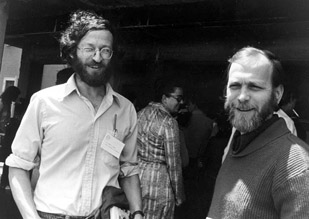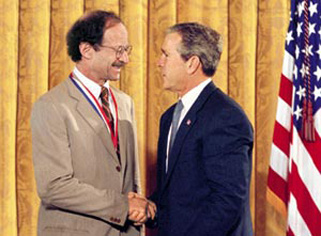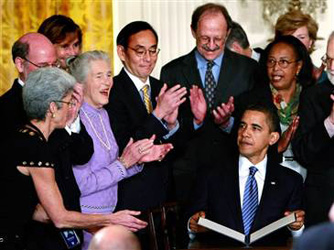Upon acceptance of the 1989 Nobel Prize in Physiology or Medicine (with Michael Bishop) for the discovery of cellular oncogenes, Harold Varmus compared the formation of cancer cells from healthy cells to a literary villain, Grendel in Beowulf, stating, "In our adventures, we have . . . seen our monster more clearly and described his scales and fangs in new ways–ways that reveal a cancer cell to be, like Grendel, a distorted version of our normal selves."
This comparison paid homage to his love of literature, which he first experienced growing up in Freeport, New York and later pursued as an undergraduate at Amherst College, serving as editor of his campus newspaper. He received a Woodrow Wilson Fellowship to further pursue English literature studies at Harvard University, earning a master's in English, but soon after decided to attend the Columbia College of Physicians and Surgeons.
 |
|
| Harold Varmus and Michael Bishop at a 1978 Cold Spring Harbor meeting. |
|
Drawn to the study of general medicine, while also fascinated by international medicine and psychiatry, he served as an apprentice in an India mission hospital, as a medical house officer at Columbia-Presbyterian Hospital, and as a Clinical Associate in Ira Pastan's laboratory at the National Institutes of Health. According to an autobiography published by The Nobel Foundation, Varmus' "studies of bacterial gene regulation by cyclic AMP" encouraged him to then pursue a postdoctoral position studying tumor virology at University of California, San Francisco Medical School, where he was first introduced to Mike Bishop in 1969. He later became a lecturer at UCSF in the Department of Microbiology and Immunology, advancing to Professor in 1979. Largely working with Bishop, he studied "the behavior of retroviruses: various aspects of their unusual life cycle, the nature and origin of their transforming genes, and their potential to cause genetic change," and also studied hemoglobinopathies, glucocorticoid action, and hepatitis B viruses with various faculty members during his 20 plus years at UCSF.
President Bill Clinton named him director of the National Institutes of Health in 1993. Serving as director until 1999, Varmus brought great change to the organization pertaining to the ways in which intramural and extramural research programs were carried out, while also filling NIH positions with respected leaders, overseeing the construction of three buildings, including the Mark O. Hatfield Clinical Research Center, and helping to increase the NIH budget.
Varmus went on to serve as the President and Chief Executive Officer of Memorial Sloan-Kettering Cancer Center, where he worked toward providing quality care to cancer patients. According to a National Cancer Institute biography, "Under his leadership, the scientific programs were reorganized and enlarged; a new research building, the Mortimer B. Zuckerman Research Center, was constructed; and new graduate training programs were established in chemical biology, computational biology, and in cancer biology." He also oversaw the construction of additional cancer centers, such as the Evelyn H. Lauder Breast Center, the MSKCC Imaging Center, and the Ralph Lauren Center for Cancer Care and Prevention.
| |
 |
| |
Harold Varmus received the National Medal of Science from President George W. Bush in 2002. |
Varmus has authored over 300 publications and several books including "The Art and Politics of Science" published in 2009. He is the recipient of many prestigious awards, including the Vannevar Bush Award and the National Medal of Science. Many awards were jointly received with Bishop, such as Scientist of the Year by the California Academy of Sciences (1982), the Lasker Award for Basic Medical Research (1982), the Gairdner Foundation Award (1983), the Alfred P. Sloan Prize of the General Motors Cancer Research Foundation (1984), and the aforementioned Nobel Prize in Physiology or Medicine (1989).
Varmus' long list of accomplishments and commitments demonstrate his passion for cancer research, global health, and greater access to the scientific literature, topics that will be highlighted at the Seaborg Symposium. He has served as an advisor to the Federal government, and to various pharmaceutical and biotechnology firms and academic institutions.
 |
|
| Harold Varmus (right, in blue shirt) joined Cabinet members, members of Congress, and other stem cell research advocates to applaud the signing an executive order by President Barack Obama on stem cell research in 2009. |
|
President Barack Obama appointed Varmas as a co-chair of the President's Council of Advisors on Science and Technology, and he has either chaired or served as a member of several influential committees and boards, including the Board of Directors of the Public Library of Science and the Scientific Board of the Grand Challenges in Global Health at the Bill and Melinda Gates Foundation.
He has also been a member of the U.S. National Academy of Sciences since 1984 and of the Institute of Medicine since 1991. President Obama nominated him as Director of the National Cancer Institute in 2010.
Varmus has been married since 1969 to Constance Casey, a journalist who writes (among other things) about "Repulsive Creatures" for Slate.com Magazine, and they have two sons, Jacob and Christopher.
Source: National Institutes of Health, National Cancer Institute, and The Nobel Foundation
